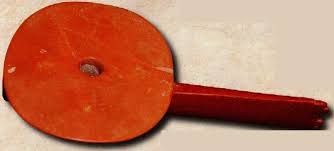By Toney Aid

This red Catlinite “Siouan” disc pipe was found at the Campbell site in Pemiscot County, Missouri. The Campbell disc pipe is large for its type. It’s base measures 73/4″ and the oval shaped disc is 4’/2″ wide at its widest point. The bowl is small (5/8″ in diameter and 1″ deep) and would have held only a small amount of tobacco. The prow of the pipe extends beyond the disc away from the smoker and has five protrusions cut into its end. The middle one is partially missing. The stem opening is opposite the prow and under the large disc. Most of the surface of the pipe was anciently polished. Below the disc, where the base and the disc join, the stone appears to have been worked with a leather thong or something similar in this hard to reach place. The surface there is cut with grooves. There is no evidence on the pipe that it has ever been worked with a file or a saw as later, historic Catlinite pipes were. The disc of the Campbell pipe was broken during its excavation, but all the pieces are present.
The Campbell disc pipe was found with a large stone paint disc and was part of a group of artifacts recovered from a shaft or pit burial in the Campbell mound. The single mound at Campbell was situated on the elevated ground of the natural levee. The height of the levee plus the dirt of the mound was high enough that a pit was sunk 15 feet deep in its middle. Most of the ground at Campbell was only 4 feet above the prehistoric water level and thus the artifacts were buried less than four feet deep. According to verbal accounts from 1977 when the pit was excavated, numerous burials were found within the ancient shaft. It was said the outline of clay steps descending the pit’s wall could also be seen. Unfortunately no inventory of the other artifacts found in the pit was kept. A similar shaft type burial was later excavated in the mound at the Chickasawba site in Mississippi County, Arkansas 15 miles southwest of Campbell. The Chickasawba shaft contained three large Catlinite disc pipes (the largest was 9 ‘/2″ long with a 5″ disc), two large flint blades, a Kaolin biscuit discoidal, a greenstone spud, a hematite plummet, a cache of Nodena blades, and several small pottery cups (Jack Roberts, personal correspondence, ND).
Catlinite disc pipes are interesting in many different key points. They clearly demonstrate how Native Americans traded “merchandise” in the form of raw and finished material over long distances. The Catlinite material from which the Campbell pipe is made was probably mined at the famous quarry in Pipestone, Minnesota. The distinctive Catlinite stone is named after the artist, George Catlin, who first described the stone being mined and made into pipes at that site in the early 1800s. Catlinite pipes are also a marker of Native American sites that were occupied very late in the prehistoric period. While Catlinite disc pipes are reported from Spiro mound in Oklahoma and Moundville in Alabama, the archaeological context for these finds is confusing. They cannot be clearly placed in the same timelines as other artifacts from these two sites. Where disc pipes can be placed in their proper archaeological context in the southern Mississippi Valley, they can usually be dated to the period from 1400 A.D. into historic times, ending by 1800 when they had been replaced by Catlinite elbow pipes. Swanton points out that the early French explorers in the 1600s and 1700s report Catlinite disc pipes as figuring prominently in the famous calumet ceremonies performed for them. However, a century earlier De Soto and his fellow explorers do not mention the calumet ceremony at all in their travels made between 1539 and 1542. It will be interesting to see if archaeological investigations bear out a date for disc pipes in the lower Mississippi Valley as being post-De Soto.
